Application of Zinc-Based Metal-Organic Framework ZIF-8 on Paper: A Pilot Study on Visual Appearance and Effectiveness
Abstract
1. Introduction
2. Materials and Methods
2.1. Sample Selection and Description
2.2. In Situ Synthesis of ZIF-8 and Application on Paper
2.3. Analytical Techniques and Papers Characterisation
3. Results and Discussion
3.1. Morphological Aspect of Papers After ZIF-8 Application
3.2. Evaluation of ZIF-8 Presence After Application via FTIR-ATR and XRF
3.3. Assessment of ZIF-8 via SEM and XRD Analysis
4. Conclusions, Final Remarks, and Future Work
Supplementary Materials
Author Contributions
Funding
Institutional Review Board Statement
Data Availability Statement
Conflicts of Interest
References
- Sesana, E.; Gagnon, A.S.; Ciantelli, C.; Cassar, J.A.; Hughes, J.J. Climate change impacts on cultural heritage: A literature review. Wiley Interdiscip. Rev. Clim. Change 2021, 12, e710. [Google Scholar] [CrossRef]
- Franco-Castillo, I.; Hierro, L.; de la Fuente, J.M.; Seral-Ascaso, A.; Mitchell, S.G. Perspectives for antimicrobial nanomaterials in cultural heritage conservation. Chem 2021, 7, 629–669. [Google Scholar] [CrossRef]
- Franco Castillo, I.; Garciá Guillén, E.; De La Fuente, J.M.; Silva, F.; Mitchell, S.G. Preventing fungal growth on heritage paper with antifungal and cellulase inhibiting magnesium oxide nanoparticles. J. Mater. Chem. B 2019, 7, 6412–6419. [Google Scholar] [CrossRef]
- Fistos, T.; Fierascu, I.; Fierascu, R.C. Recent Developments in the Application of Inorganic Nanomaterials and Nanosystems for the Protection of Cultural Heritage Organic Artifacts. Nanomaterials 2022, 12, 207. [Google Scholar] [CrossRef]
- Alexopoulou, I.; Zervos, S. Paper conservation methods: An international survey. J. Cult. Herit. 2016, 21, 922–930. [Google Scholar] [CrossRef]
- Pérez-Gandarillas, L.; Manteca, C.; Yedra, Á.; Casas, A. Conservation and Protection Treatments for Cultural Heritage: Insights and Trends from a Bibliometric Analysis. Coatings 2024, 14, 1027. [Google Scholar] [CrossRef]
- Sequeira, S.; Cabrita, E.J.; Macedo, M.F. Antifungals on paper conservation: An overview. Int. Biodeterior. Biodegrad. 2012, 74, 67–86. [Google Scholar] [CrossRef]
- Zervos, S.; Moropoulou, A. Methodology and criteria for the evaluation of paper conservation interventions: A literature review. Restaurator 2006, 27, 219–274. [Google Scholar] [CrossRef]
- Stella Gomez-Villalba, L.; Salcines, C.; Fort, R. Application of Inorganic Nanomaterials in Cultural Heritage Conservation, Risk of Toxicity, and Preventive Measures. Nanomaterials 2023, 13, 1454. [Google Scholar] [CrossRef]
- Kakakhel, M.A.; Wu, F.; Gu, J.D.; Feng, H.; Shah, K.; Wang, W. Controlling biodeterioration of cultural heritage objects with biocides: A review. Int. Biodeterior. Biodegrad. 2019, 143, 104721–104731. [Google Scholar] [CrossRef]
- Roman, C.; Diaconescu, R.; Scripcariu, L.; Grigoriu, A. Biocides used in preservation, restoration and conservation of the paper. Eur. J. Sci. Theol. 2013, 9, 263–271. [Google Scholar]
- Magaudda, G. The recovery of biodeteriorated books and archive documents through gamma radiation: Some considerations on the results achieved. J. Cult. Herit. 2004, 5, 113–118. [Google Scholar] [CrossRef]
- Sequeira, S.O.; Phillips, A.J.L.; Cabrita, E.J.; Macedo, M.F. Ethanol as an antifungal treatment for paper: Short-term and long-term effects. Stud. Conserv. 2017, 62, 33–42. [Google Scholar] [CrossRef]
- Gautam, B.; Ali, S.A.; Chen, J.T.; Yu, H.H. Hybrid “kill and Release” Antibacterial Cellulose Papers Obtained via Surface-Initiated Atom Transfer Radical Polymerization. ACS Appl. Bio Mater. 2021, 4, 7893–7902. [Google Scholar] [CrossRef] [PubMed]
- Afsharpour, M.; Hadadi, M. Titanium dioxide thin film: Environmental control for preservation of paper-art-works. J. Cult. Herit. 2014, 15, 569–574. [Google Scholar] [CrossRef]
- He, S.M.; Wang, F.; Zhang, L.; Zhang, J.Y.; Zeng, F.R.; Liu, B.W.; Luo, Y.B.; Wang, Y.Z.; Zhao, H.B. Quick and efficient flame-retardant, antibacterial and antifungal treatment for high-performance cellulose paper. Prog. Org. Coatings 2023, 185, 107947–107956. [Google Scholar] [CrossRef]
- Tang, Y.; Yan, Y.; Yang, Y.; Mou, H.; Wu, T.; Ji, X.; Zhang, H.; Wu, X.; Fan, H. Multi-Functional Repair and Long-Term Preservation of Paper Relics by Nano-MgO with Aminosilaned Bacterial Cellulose. Molecules 2024, 29, 3959. [Google Scholar] [CrossRef]
- Fidanza, M.R.; Caneva, G. Natural biocides for the conservation of stone cultural heritage: A review. J. Cult. Herit. 2019, 38, 271–286. [Google Scholar] [CrossRef]
- Corbu, V.M.; Gheorghe-Barbu, I.; Marinas, I.C.; Avramescu, S.M.; Pecete, I.; Geanǎ, E.I.; Chifiriuc, M.C. Eco-Friendly Solution Based on Rosmarinus officinalis Hydro-Alcoholic Extract to Prevent Biodeterioration of Cultural Heritage Objects and Buildings. Int. J. Mol. Sci. 2022, 23, 11463. [Google Scholar] [CrossRef]
- Kanth, A.P.; Soni, A.K. Application of nanocomposites for conservation of materials of cultural heritage. J. Cult. Herit. 2023, 59, 120–130. [Google Scholar] [CrossRef]
- Fornari, A.; Rossi, M.; Rocco, D.; Mattiello, L. A Review of Applications of Nanocellulose to Preserve and Protect Cultural Heritage Wood, Paintings, and Historical Papers. Appl. Sci. 2022, 12, 12846. [Google Scholar] [CrossRef]
- Tsai, T.T.; Huang, T.H.; Chang, C.J.; Yi-Ju Ho, N.; Tseng, Y.T.; Chen, C.F. Antibacterial cellulose paper made with silver-coated gold nanoparticles. Sci. Rep. 2017, 7, 3155–3165. [Google Scholar] [CrossRef]
- Yang, J.; Yang, Y.W. Metal–Organic Frameworks for Biomedical Applications. Small 2020, 16, 1906846. [Google Scholar] [CrossRef] [PubMed]
- Di Matteo, V.; Di Filippo, M.F.; Ballarin, B.; Gentilomi, G.A.; Bonvicini, F.; Panzavolta, S.; Cassani, M.C. Cellulose/Zeolitic Imidazolate Framework (ZIF-8) Composites with Antibacterial Properties for the Management of Wound Infections. J. Funct. Biomater. 2023, 14, 472. [Google Scholar] [CrossRef] [PubMed]
- Liu, J.; Wu, D.; Zhu, N.; Wu, Y.; Li, G. Antibacterial mechanisms and applications of metal-organic frameworks and their derived nanomaterials. Trends Food Sci. Technol. 2021, 109, 413–434. [Google Scholar] [CrossRef]
- Horcajada, P.; Gref, R.; Baati, T.; Allan, P.K.; Maurin, G.; Couvreur, P.; Férey, G.; Morris, R.E.; Serre, C. Metal-organic frameworks in biomedicine. Chem. Rev. 2012, 112, 1232–1268. [Google Scholar] [CrossRef] [PubMed]
- Shen, M.; Forghani, F.; Kong, X.; Liu, D.; Ye, X.; Chen, S.; Ding, T. Antibacterial applications of metal-organic frameworks and their composites. Compr. Rev. food Sci. food Saf. 2020, 19, 1397–1419. [Google Scholar] [CrossRef]
- Taheri, M.; Ashok, D.; Sen, T.; Enge, T.G.; Verma, N.K.; Tricoli, A.; Lowe, A.; Nisbet, D.R.; Tsuzuki, T. Stability of ZIF-8 nanopowders in bacterial culture media and its implication for antibacterial properties. Chem. Eng. J. 2021, 413, 127511–127521. [Google Scholar] [CrossRef]
- Dedecker, K.; Pillai, R.S.; Nouar, F.; Pires, J.; Steunou, N.; Dumas, E.; Maurin, G.; Serre, C.; Pinto, M.L. Metal-Organic Frameworks for Cultural Heritage Preservation: The Case of Acetic Acid Removal. ACS Appl. Mater. Interfaces 2018, 10, 13886–13894. [Google Scholar] [CrossRef]
- Al Mohtar, A.; Severino, M.I.; Tignol, P.; Ranza, L.; Neves, A.; Nouar, F.; Pimenta, V.; Lopes, J.; Ramos, A.M.; Rodrigo, J.I.L.; et al. Iron(III) based Metal-Organic Frameworks in cellulose acetate film preservation: Fundamental aspects and first application. J. Cult. Herit. 2024, 66, 236–243. [Google Scholar] [CrossRef]
- Al Mohtar, A.; Pinto, M.L.; Neves, A.; Nunes, S.; Zappi, D.; Varani, G.; Ramos, A.M.; Melo, M.J.; Wallaszkovits, N.; Lahoz Rodrigo, J.I.; et al. Decision making based on hybrid modeling approach applied to cellulose acetate based historical films conservation. Sci. Rep. 2021, 11, 16074–16087. [Google Scholar] [CrossRef] [PubMed]
- Freitas, C.; Severino, M.I.; Al Mohtar, A.; Kolmykov, O.; Pimenta, V.; Nouar, F.; Serre, C.; Pinto, M. Metal-Organic Frameworks Polyurethane Composite Foams for the Capture of Volatile Organic Compounds. ACS Mater. Lett. 2024, 6, 174–181. [Google Scholar] [CrossRef]
- Zhou, K.; Shi, Z.; Yi, X.-H.; Wang, P.; Li, A.; Wang, C.-C. MOFs helping heritage against environmental threats. Chinese Chem. Lett. 2024, 24, 110236110246. [Google Scholar] [CrossRef]
- Mocioiu, O.C.; Atkinson, I.; Mocioiu, A.M.; Neagu, S.; Ruginescu, R.; Mitran, R.A.; Enache, M. Effect of zno on properties of gels for heritage objects conservation. Gels 2021, 7, 251. [Google Scholar] [CrossRef]
- Bergamonti, L.; Potenza, M.; Haghighi Poshtiri, A.; Lorenzi, A.; Sanangelantoni, A.M.; Lazzarini, L.; Lottici, P.P.; Graiff, C. Ag-functionalized nanocrystalline cellulose for paper preservation and strengthening. Carbohydr. Polym. 2020, 231, 115773. [Google Scholar] [CrossRef]
- Jia, M.; Zhang, X.; Weng, J.; Zhang, J.; Zhang, M. Protective coating of paper works: ZnO/cellulose nanocrystal composites and analytical characterization. J. Cult. Herit. 2019, 38, 64–74. [Google Scholar] [CrossRef]
- Li, Y.; Wang, J.; Jia, Z.; Zhou, Y.; Chao, X.; Terigele; Li, J.; Li, Y.; Xing, H. Deacidification and consolidation of brittle book paper using bacterial cellulose composite with zinc oxide nanoparticles. J. Cult. Herit. 2023, 64, 83–91. [Google Scholar] [CrossRef]
- Yang, R.; Liu, B.; Yu, F.; Li, H.; Zhuang, Y. Superhydrophobic cellulose paper with sustained antibacterial activity prepared by in-situ growth of carvacrol-loaded zinc-based metal organic framework nanorods for food packaging application. Int. J. Biol. Macromol. 2023, 234, 123712–123723. [Google Scholar] [CrossRef]
- Afsharpour, M.; Imani, S. Preventive protection of paper works by using nanocomposite coating of zinc oxide. J. Cult. Herit. 2017, 25, 142–148. [Google Scholar] [CrossRef]
- Area, M.C.; Cheradame, H. Paper aging and degradation: Recent findings and research methods. BioResources 2011, 6, 5307–5337. [Google Scholar] [CrossRef]
- Roberts, J.C. (Ed.) Paper Chemistry, 2nd ed.; Springer: Dordrecht, The Netherlands, 1996; ISBN 978-0-7514-0236-0. [Google Scholar]
- Es-sabbeur, S.; Kamal, O.; Louafy, R.; Cherif, A.; Elkoraichi, I.; Lebrun, L.; Hlaibi, M. Restoration and conservation of heritage written on cellulosic support (paper, papyrus, and wood). Characteristic study. Mater. Today Proc. 2023, 72, 3696–3704. [Google Scholar] [CrossRef]
- Arai, H. Foxing caused by fungi: Twenty-five years of study. Int. Biodeterior. Biodegrad. 2000, 46, 181–188. [Google Scholar] [CrossRef]
- Margutti, S.; Conio, G.; Calvini, P.; Pedemonte, E. Hydrolytic and oxidative degradation of paper. Restaurator 2001, 22, 67–83. [Google Scholar] [CrossRef]
- Mandal, S.; Kumar, P.; Satpathy, B.; Das, K.; Das, S. Nanostructured metal oxide based coating for the protection and conservation of cultural heritage: A comprehensive review. J. Cult. Herit. 2024, 69, 94–112. [Google Scholar] [CrossRef]
- Zervos, S.; Alexopoulou, I. Paper conservation methods: A literature review. Cellulose 2015, 22, 2859–2897. [Google Scholar] [CrossRef]
- Kaskel, S. (Ed.) The Chemistry of Metal-Organic Frameworks: Synthesis, Characterization, and Applications; Wiley-VCH Verlag GmbH & Co. KGaA: Hoboken, NJ, USA, 2016; ISBN 9783527693078. [Google Scholar]
- Wang, A.; Walden, M.; Ettlinger, R.; Kiessling, F.; Gassensmith, J.J.; Lammers, T.; Wuttke, S.; Peña, Q. Biomedical Metal–Organic Framework Materials: Perspectives and Challenges. Adv. Funct. Mater. 2024, 34, 2308589. [Google Scholar] [CrossRef] [PubMed]
- Kouser, S.; Hezam, A.; Khadri, M.J.N.; Khanum, S.A. A review on zeolite imidazole frameworks: Synthesis, properties, and applications. J. Porous Mater. 2022, 29, 663–681. [Google Scholar] [CrossRef]
- Ploetz, E.; Engelke, H.; Lächelt, U.; Wuttke, S. The Chemistry of Reticular Framework Nanoparticles: MOF, ZIF, and COF Materials. Adv. Funct. Mater. 2020, 30, 1909062–1909139. [Google Scholar] [CrossRef]
- Chen, B.; Yang, Z.; Zhu, Y.; Xia, Y. Zeolitic imidazolate framework materials: Recent progress in synthesis and applications. J. Mater. Chem. A 2014, 2, 16811–16831. [Google Scholar] [CrossRef]
- Venna, S.R.; Jasinski, J.B.; Carreon, M.A. Structural evolution of zeolitic imidazolate framework-8. J. Am. Chem. Soc. 2010, 132, 18030–18033. [Google Scholar] [CrossRef]
- Di Matteo, V.; Di Filippo, M.F.; Ballarin, B.; Bonvicini, F.; Iaquinta, M.R.; Panzavolta, S.; Mazzoni, E.; Cassani, M.C. Porous titanium scaffolds modified with Zeolitic Imidazolate Framework (ZIF-8) with enhanced osteogenic activity for the prevention of implant-associated infections. Front. Chem. 2024, 12, 1452670–1452683. [Google Scholar] [CrossRef] [PubMed]
- Park, K.S.; Ni, Z.; Côté, A.P.; Choi, J.Y.; Huang, R.; Uribe-Romo, F.J.; Chae, H.K.; O’Keeffe, M.; Yaghi, O.M. Exceptional chemical and thermal stability of zeolitic imidazolate frameworks. Proc. Natl. Acad. Sci. USA 2006, 103, 10186–10191. [Google Scholar] [CrossRef]
- Casoli, A.; Cremonesi, P.; Isca, C.; Groppetti, R.; Pini, S.; Senin, N. Evaluation of the effect of cleaning on the morphological properties of ancient paper surface. Cellulose 2013, 20, 2027–2043. [Google Scholar] [CrossRef]
- ISO/CIE 11664-2:2022 | EN ISO/CIE 11664-2:2022; Colorimetry Part 2: CIE Standard Illuminants. ISO: Geneva, Switzerland, 2022.
- Feller, R.J. Color Science in the Examination of Museum Objects: Nondestructive Procedures, 1st ed.; Getty Conservation Institute: Los Angeles, CA, USA, 2001. [Google Scholar]
- Costantini, R.; Balliana, E.; Dalla Torre, D.; Aricò, F.; Zendri, E. Evaluating the Impacts of Alcohol-Based Solutions on Silk: Chemical, Mechanical and Wettability Changes before and after Artificial Ageing. Heritage 2022, 5, 3588–3604. [Google Scholar] [CrossRef]
- Albertin, F.; Balliana, E.; Pizzol, G.; Colavizza, G.; Zendri, E.; Raines, D. Printing materials and technologies in the 15th–17th century book production: An undervalued research field. Microchem. J. 2018, 138, 147–153. [Google Scholar] [CrossRef]
- Canals, T.; Riba, J.R.; Cantero, R.; Cansino, J.; Domingo, D.; Iturriaga, H. Characterization of paper finishes by use of infrared spectroscopy in combination with canonical variate analysis. Talanta 2008, 77, 751–757. [Google Scholar] [CrossRef]
- Garside, P.; Wyeth, P. Identification of Cellulosic Fibres by FTIR Spectroscopy—Thread and Single Fibre Analysis by Attenuated Total Reflectance. Stud. Conserv. 2003, 48, 269–275. [Google Scholar] [CrossRef]
- Conners, T.E.; Banerjee, S. Surface Analysis of Paper, 1st ed.; CRC Press: Boca Raton, FL, USA, 2020; ISBN 9780429279997. [Google Scholar]
- Ran, J.; Chen, H.; Bi, S.; Guo, Q.; Deng, Z.; Cai, G.; Cheng, D.; Tang, X.; Wang, X. One-step in-situ growth of zeolitic imidazole frameworks-8 on cotton fabrics for photocatalysis and antimicrobial activity. Cellulose 2020, 27, 10447–10459. [Google Scholar] [CrossRef]
- Falcaro, P.; Carraro, F.; Velásquez-Hernández, M.D.J.; Astria, E.; Liang, W.; Twight, L.; Parise, C.; Ge, M.; Huang, Z.; Ricco, R.; et al. Phase dependent encapsulation and release profile of ZIF-based biocomposites. Chem. Sci. 2020, 11, 3397–3404. [Google Scholar] [CrossRef]
- James, J.B.; Lin, Y.S. Kinetics of ZIF-8 Thermal Decomposition in Inert, Oxidizing, and Reducing Environments. J. Phys. Chem. C 2016, 120, 14015–14026. [Google Scholar] [CrossRef]
- Paro, E.; Benvestito, C.; Pugliese, S.; Izzo, F.C.; Balliana, E.; Zendri, E. Study and characterization of paper bookbindings from 16 to 18th stored in the Marciana National Library (Venice). Herit. Sci. 2024, 12, 1–14. [Google Scholar] [CrossRef]
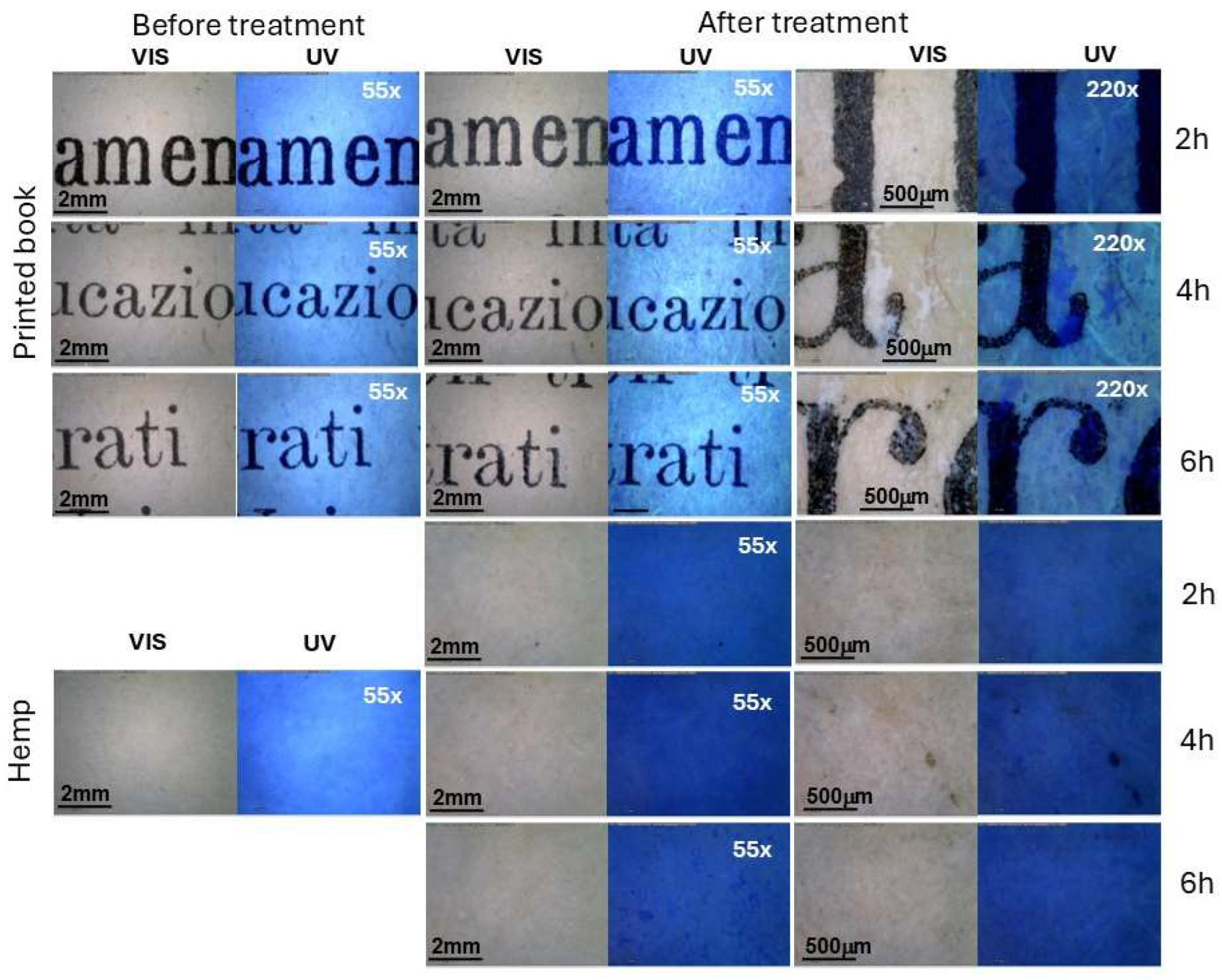
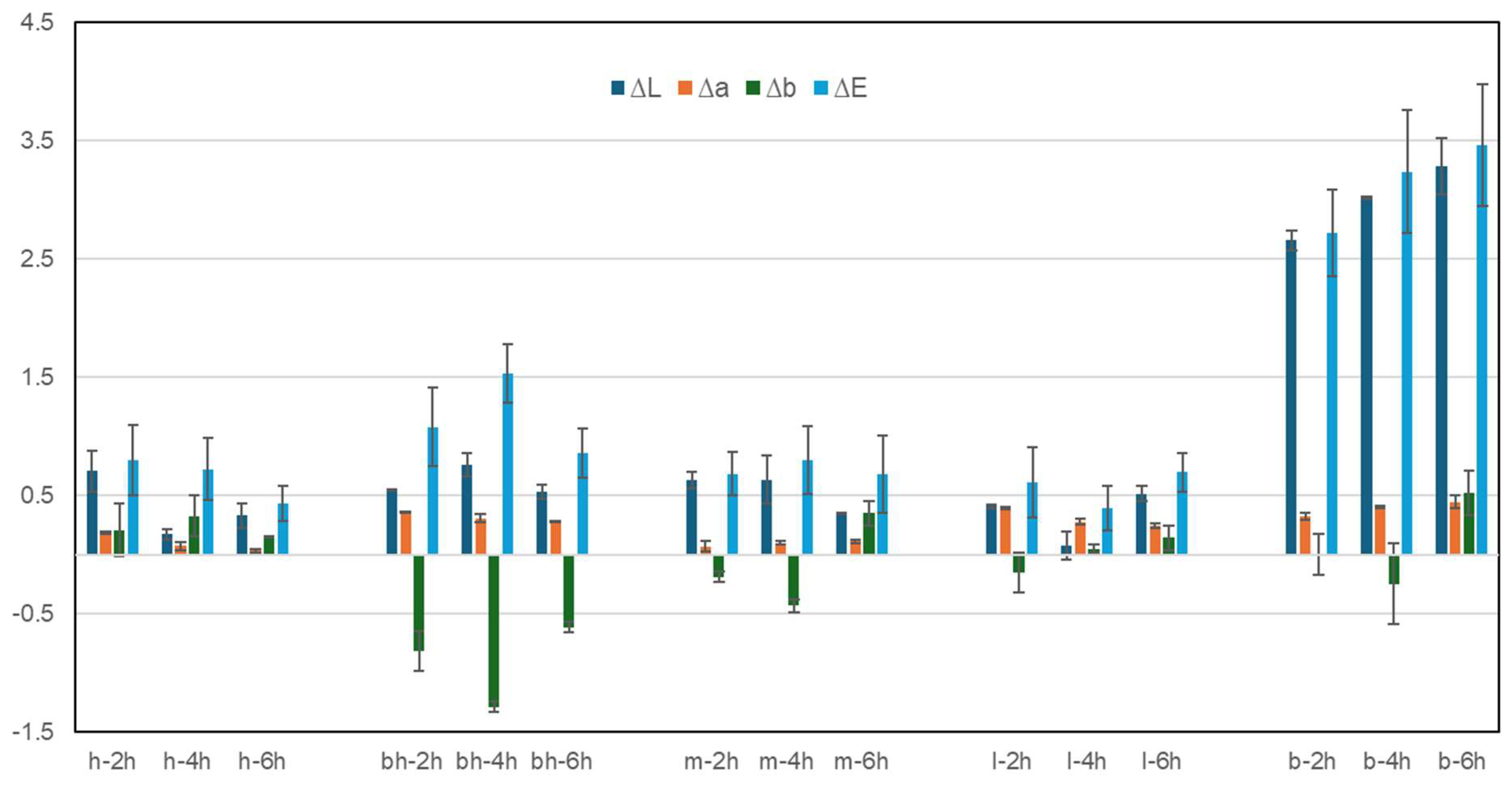
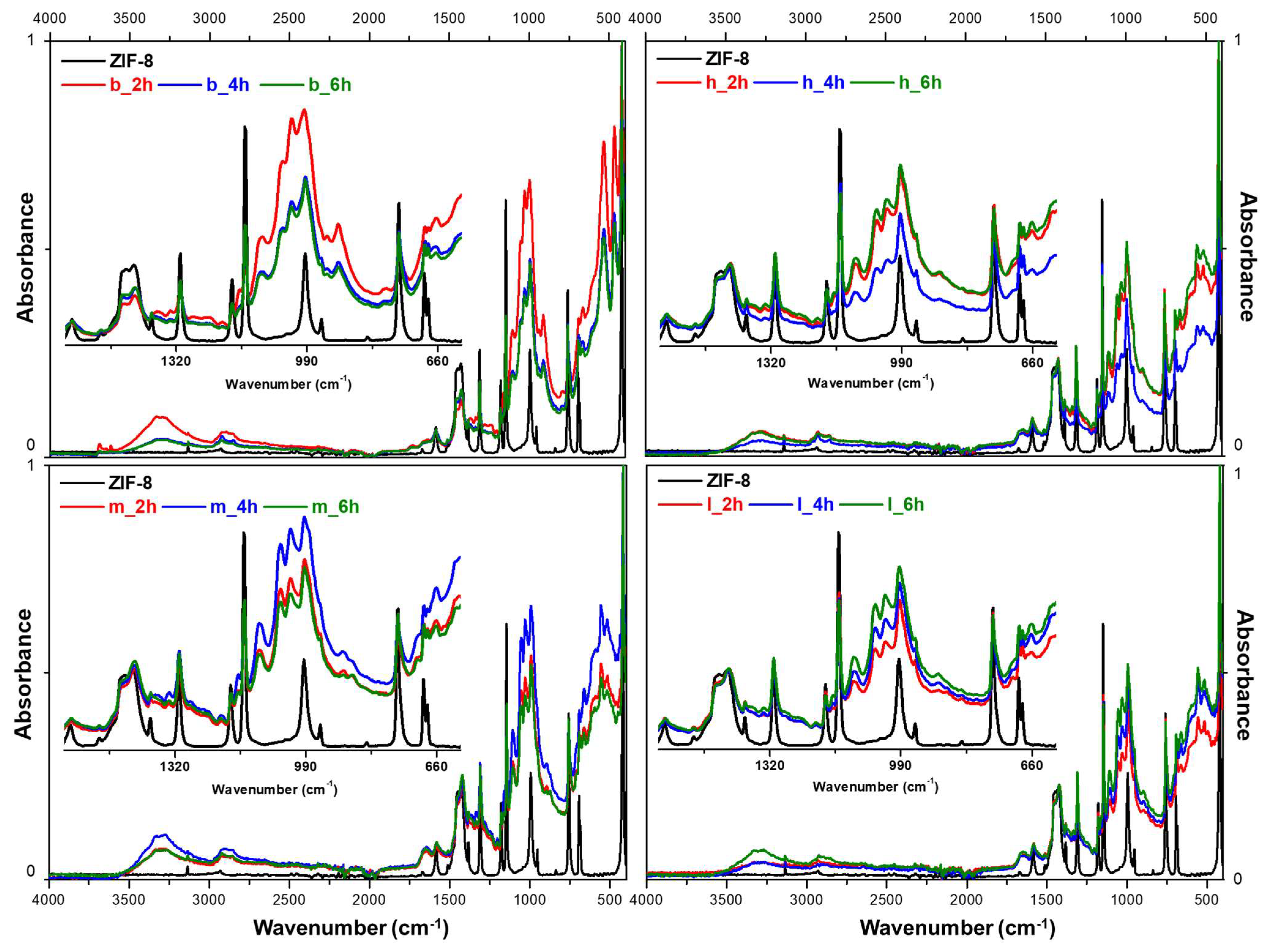
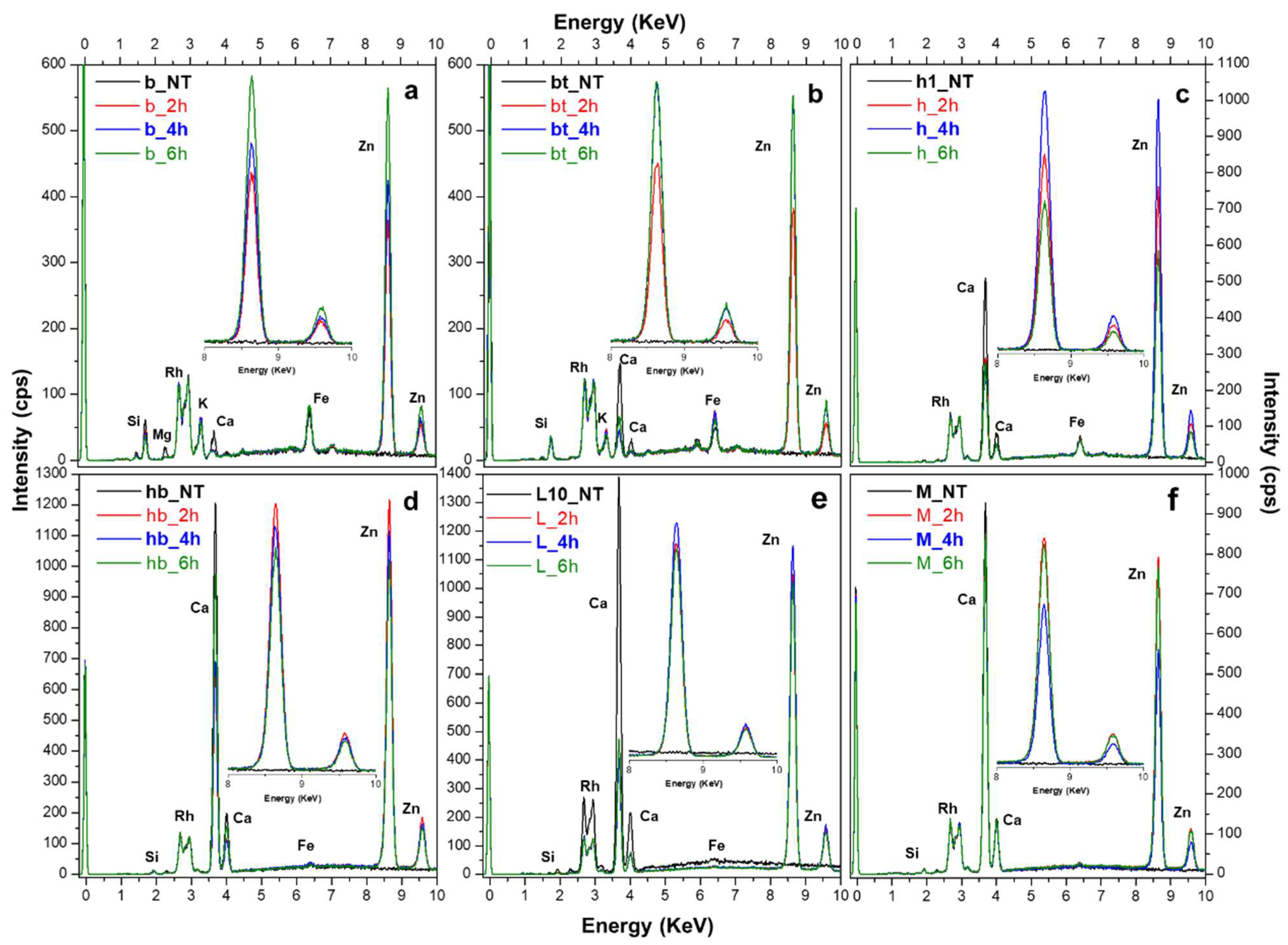

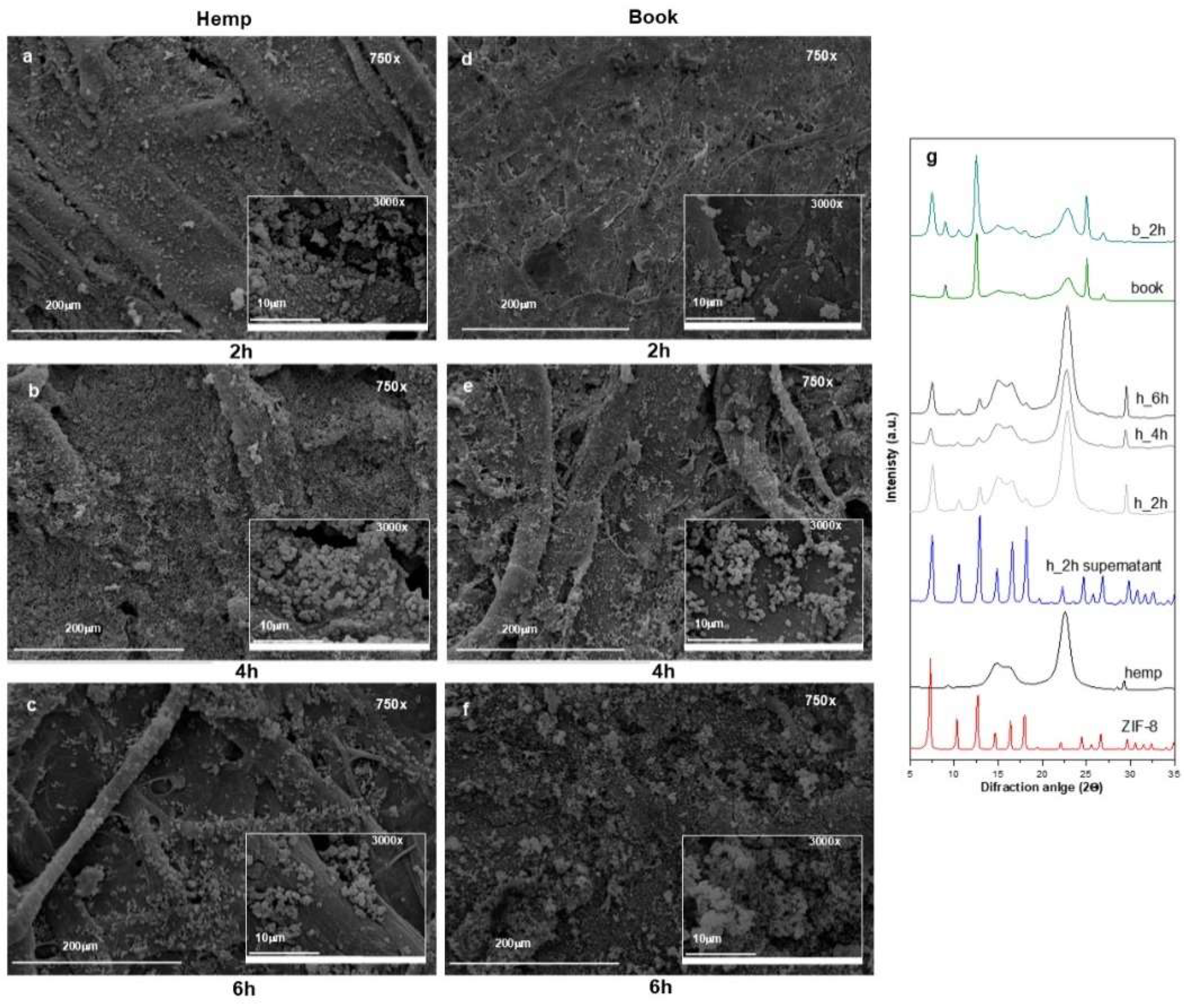
| Sample ID | Description |
|---|---|
| Hemp—h | Pure hand-made hemp paper |
| Bleached Hemp—bh | Pure bleached hand-made hemp paper |
| Mix Hemp-Linen—m | Mixed hand-made hemp (60%) and linen (40%) paper |
| Linen—l | Pure hand-made paper linen |
| Book—b | Commercial-coated paper from the late 1900 |
| Printed book—pb | Commercial-coated paper from the late 1900 |
| Application Time 2 h | Application Time 4 h | Application Time 6 h | ||||||||||
|---|---|---|---|---|---|---|---|---|---|---|---|---|
| Type of Paper | Sample Id | Wi | Wf | %W | Sample Id | Wi | Wf | %W | Sample Id | Wi | Wf | %W |
| Book—b | R_b20_2h | 0.116 | 0.115 | −1 | R_b23_4h | 0.116 | 0.115 | 1 | R_b26_6h | 0.121 | 0.120 | 0 |
| R_b21_2h | 0.117 | 0.116 | −1 | R_b24_4h | 0.120 | 0.120 | 0 | R_b27_6h | 0.118 | 0.117 | −1 | |
| R_b22_2h | 0.115 | 0.115 | 0 | R_b25_4h | 0.119 | 0.118 | 1 | R_b28_6h | 0.115 | 0.115 | 0 | |
| b1_2h | 0.149 | 0.149 | 0 | b9_4h | 0.146 | 0.154 | 5 | b3_6h | 0.142 | 0.146 | 3 | |
| b7_2h | 0.110 | 0.112 | 2 | b4_4h | 0.136 | 0.143 | 5 | b2_6h | 0.153 | 0.159 | 4 | |
| b8_2h | 0.109 | 0.110 | 1 | b6_4h | 0.117 | 0.124 | 6 | b5_6h | 0.095 | 0.100 | 5 | |
| Printed book—pb | R_pb20_2h | 0.117 | 0.117 | 0 | R_pb23_4h | 0.103 | 0.102 | 1 | R_pb26_4h | 0.109 | 0.109 | 0 |
| R_pb21_2h | 0.115 | 0.113 | −1 | R_pb24_4h | 0.122 | 0.121 | 1 | R_pb27_4h | 0.103 | 0.103 | 0 | |
| R_pb22_2h | 0.120 | 0.120 | 0 | R_pb25_4h | 0.109 | 0.109 | 0 | R_pb28_4h | 0.107 | 0.106 | −1 | |
| pb5_2h | 0.133 | 0.133 | 0 | pb2_4h | 0.175 | 0.181 | 3 | pb3_6h | 0.183 | 0.194 | 6 | |
| pb6_2h | 0.131 | 0.132 | 1 | pb1_4h | 0.131 | 0.135 | 3 | pb9_6h | 0.167 | 0.176 | 5 | |
| pb4_2h | 0.174 | 0.177 | 2 | pb7_4h | 0.132 | 0.140 | 6 | pb8_6h | 0.135 | 0.139 | 3 | |
| Linen—l | R_l20_2h | 0.260 | 0.260 | 0 | R_l23_4h | 0.304 | 0.301 | 0 | R_l26_6h | 0.370 | 0.365 | −1 |
| R_l21_2h | 0.358 | 0.349 | −2 | R_l24_4h | 0.348 | 0.346 | 1 | R_l27_6h | 0.351 | 0.350 | 0 | |
| R_l22_2h | 0.320 | 0.320 | 0 | R_l25_4h | 0.321 | 0.321 | 0 | R_l28_6h | 0.362 | 0.361 | 0 | |
| l5_2h | 0.305 | 0.309 | 1 | l2_4h | 0.306 | 0.319 | 4 | l6_6h | 0.309 | 0.310 | 0 | |
| l3_2h | 0.312 | 0.321 | 3 | l1_4h | 0.330 | 0.341 | 3 | l7_6h | 0.270 | 0.279 | 3 | |
| l9_2h | 0.380 | 0.381 | 0 | l8_4h | 0.318 | 0.328 | 3 | l4_6h | 0.409 | 0.419 | 2 | |
| Hemp—h | R_h20_2h | 0.300 | 0.299 | R23_h_4h | 0.341 | 0.340 | 1 | R26_h_6h | 0.321 | 0.321 | 0 | |
| R_h21_2h | 0.334 | 0.329 | R24_h_4h | 0.282 | 0.279 | 0 | R27_h_6h | 0.344 | 0.342 | 0 | ||
| R_h22_2h | 0.304 | 0.303 | R25_h_4h | 0.340 | 0.340 | 0 | R28_h_6h | 0.322 | 0.320 | 0 | ||
| h4_2h | 0.237 | 0.237 | 0 | h9_4h | 0.247 | 0.254 | 3 | h8_6h | 0.235 | 0.236 | 0 | |
| h3_2h | 0.248 | 0.254 | 2 | h2_4h | 0.269 | 0.274 | 2 | h5_6h | 0.233 | 0.239 | 3 | |
| h1_2h | 0.269 | 0.271 | 1 | h7_4h | 0.245 | 0.256 | 4 | h6_6h | 0.250 | 0.250 | 0 | |
| Bleached Hemp—bh | R_bh20_2h | 0.435 | 0.434 | 0 | R_bh23_4h | 0.451 | 0.448 | 1 | R_bh26_6h | 0.334 | 0.333 | 0 |
| R_bh21_2h | 0.463 | 0.459 | −1 | R_bh24_4h | 0.419 | 0.419 | 0 | R_bh27_6h | 0.403 | 0.401 | 0 | |
| R_bh22_2h | 0.443 | 0.443 | 0 | R_bh25_4h | 0.433 | 0.432 | 0 | R_bh28_6h | 0.402 | 0.404 | 0 | |
| bh2_2h | 0.409 | 0.417 | 2 | bh9_4h | 0.441 | 0.451 | 2 | bh1_6h | 0.368 | 0.373 | 1 | |
| bh6_2h | 0.586 | 0.591 | 1 | bh4_4h | 0.540 | 0.551 | 2 | bh5_6h | 0.504 | 0.513 | 2 | |
| bh7_2h | 0.475 | 0.476 | 0 | bh8_4h | 0.535 | 0.559 | 4 | bh3_6h | 0.441 | 0.448 | 2 | |
| Mixed hemp/linen—m | R_m20_2h | 0.261 | 0.261 | 0 | R_m23_4h | 0.250 | 0.249 | 0 | R_m26_6h | 0.242 | 0.240 | −1 |
| R_m21_2h | 0.183 | 0.181 | −1 | R_m24_4h | 0.275 | 0.274 | 0 | R_m24_6h | 0.281 | 0.280 | −1 | |
| R_m22_2h | 0.231 | 0.231 | 0 | R_m25_4h | 0.265 | 0.264 | 0 | R_m28_6h | 0.247 | 0.247 | 0 | |
| m2_2h | 0.281 | 0.284 | 1 | m3_4h | 0.226 | 0.230 | 2 | m4_6h | 0.264 | 0.267 | 1 | |
| m6_2h | 0.201 | 0.201 | 0 | m1_4h | 0.256 | 0.261 | 2 | m5_6h | 0.274 | 0.275 | 0 | |
| m8_2h | 0.282 | 0.284 | 1 | m7_4h | 0.259 | 0.267 | 3 | m9_6h | 0.255 | 0.257 | 1 | |
Disclaimer/Publisher’s Note: The statements, opinions and data contained in all publications are solely those of the individual author(s) and contributor(s) and not of MDPI and/or the editor(s). MDPI and/or the editor(s) disclaim responsibility for any injury to people or property resulting from any ideas, methods, instructions or products referred to in the content. |
© 2025 by the authors. Licensee MDPI, Basel, Switzerland. This article is an open access article distributed under the terms and conditions of the Creative Commons Attribution (CC BY) license (https://creativecommons.org/licenses/by/4.0/).
Share and Cite
Balliana, E.; Marchand, M.; Di Matteo, V.; Ballarin, B.; Cassani, M.C.; Panzavolta, S.; Zendri, E. Application of Zinc-Based Metal-Organic Framework ZIF-8 on Paper: A Pilot Study on Visual Appearance and Effectiveness. Polymers 2025, 17, 1369. https://doi.org/10.3390/polym17101369
Balliana E, Marchand M, Di Matteo V, Ballarin B, Cassani MC, Panzavolta S, Zendri E. Application of Zinc-Based Metal-Organic Framework ZIF-8 on Paper: A Pilot Study on Visual Appearance and Effectiveness. Polymers. 2025; 17(10):1369. https://doi.org/10.3390/polym17101369
Chicago/Turabian StyleBalliana, Eleonora, Mathilde Marchand, Valentina Di Matteo, Barbara Ballarin, Maria Cristina Cassani, Silvia Panzavolta, and Elisabetta Zendri. 2025. "Application of Zinc-Based Metal-Organic Framework ZIF-8 on Paper: A Pilot Study on Visual Appearance and Effectiveness" Polymers 17, no. 10: 1369. https://doi.org/10.3390/polym17101369
APA StyleBalliana, E., Marchand, M., Di Matteo, V., Ballarin, B., Cassani, M. C., Panzavolta, S., & Zendri, E. (2025). Application of Zinc-Based Metal-Organic Framework ZIF-8 on Paper: A Pilot Study on Visual Appearance and Effectiveness. Polymers, 17(10), 1369. https://doi.org/10.3390/polym17101369







